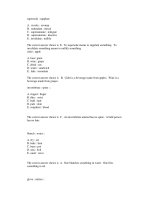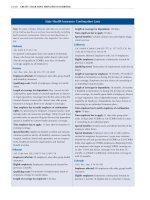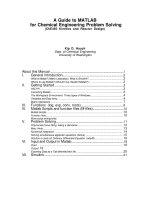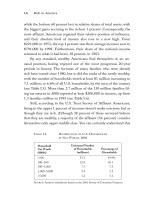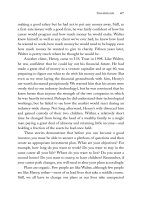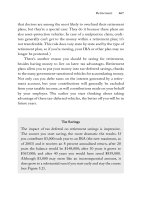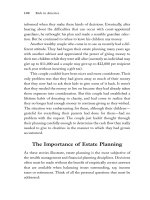101 activities foteaching creativity and problem solving phần 9 doc
Bạn đang xem bản rút gọn của tài liệu. Xem và tải ngay bản đầy đủ của tài liệu tại đây (323.86 KB, 41 trang )
• What did you learn?
• What will we be able to use from this exercise?
• What ideas were generated, and which ones were most interesting?
Variation
• Have the participants use people personally known to everyone. This person could be
a co-worker, manager, secretary, staff person, or anyone else known to them. Caution
them to be careful about any inappropriate characterizations that might be harmful or
disrespectful to others.
316
101 Activities for Teaching Creativity and Problem Solving
10 VG 295-328 10/6/04 1:05 PM Page 316
TLFeBOOK
78
Roll Call
Background
Are you an extrovert? Did you always try to answer teachers’
questions in school? Do you like to shout out ideas when
brainstorming? Do you shoot from the hip? If you answered
yes to any of these questions, then you and others like you
probably will enjoy this activity.
Although we have been taught to think before we speak,
this advice may sometimes be counterproductive. If we think
too much before we talk during idea generation, we may judge
our ideas prematurely and restrict our creativity. Self-censors
are the enemies of all creative thought and that is the basis for
this activity, developed by Hall (1994).
Objectives
• To help participants generate as many creative ideas as possible
• To help participants learn how to use the activities to generate ideas
Participants
Small groups of four to seven people each
Materials, Supplies, and Equipment
• For each group: markers, two flip charts, and masking tape for posting flip-chart
sheets
• For each participant: one sheet each of three different colors of sticking dots
(
1
⁄2” diameter) and one pad of 4 x 6 Post-it
®
Notes
Handout
• Roll Call Handout
317
Brainstorming with Unrelated Stimuli
10 VG 295-328 10/6/04 1:05 PM Page 317
TLFeBOOK
Time
45 minutes
Related Activities
• Text Tickler [20]
• Blender [58]
• Force-Fit Game [74]
Procedure
1. Divide the participants into groups of six people.
2. Distribute the Roll Call Handout, review it with the participants, and answer any
questions they may have.
3. Ask half the members of each group to call out one word each. Explain that the
words should be whatever pops into their heads. Note also that they shouldn’t
think very long about what word to say and that the words should be unrelated to
the problem.
4. Give the group members 104 seconds to create a practical idea based on combin-
ing the three words or using the individual words for stimulation. (Hall doesn’t
say why he chose 104 seconds, but probably just to be different.)
5. Instruct them to write down their ideas on Post-it
®
Notes (one idea per note) and
place them on a flip chart for evaluation.
6. Ask the participants to repeat Steps 3 to 5, but have the remaining group members
call out the words.
7. Repeat this process again using the original three members to call out new words
and continue until time is called.
Debrief/Discussion
Unlike many situations in life, this activity works best when you talk before you think. Its
major strength is that it encourages spontaneity and helps eliminate judgmental thinking.
Group members are forced to leap to conclusions instead of leaping to ideas. Thus, they
have little choice but to defer judgment and the result should be more novel ideas than
had they constrained themselves.
Also consider having participants debrief using the following questions:
• What was most helpful about this exercise?
• What was most challenging?
• What can we apply?
• How would you rate the value of this exercise to helping us with this issue?
• Will this exercise be helpful in the future for other sessions?
318
101 Activities for Teaching Creativity and Problem Solving
10 VG 295-328 10/6/04 1:05 PM Page 318
TLFeBOOK
• What did you learn?
• What will we be able to use from this exercise?
• What ideas were generated, and which ones were most interesting?
319
Brainstorming with Unrelated Stimuli
10 VG 295-328 10/6/04 1:05 PM Page 319
TLFeBOOK
Roll Call Handout
Assume your group is dealing with the problem of how to improve a kitchen table.
Group members call out such words as “radio,” “penguin,” and “icicle.” The group then
uses these words to prompt ideas:
• Radio built into the table
• Musical lazy Susan with a cooling mechanism that keeps food cold
• Table designed with a tuxedo motif
• Table with holders to keep drinks cold
• Table with an “arctic” motif
• A “penguin table” with leaves that resemble penguin wings
320
101 Activities for Teaching Creativity and Problem Solving
101 Activities for Teaching Creativity and Problem Solving. Copyright © 2005 by John Wiley &
Sons, Inc. Reproduced by permission of Pfeiffer, an Imprint of Wiley. www.pfeiffer.com
10 VG 295-328 10/6/04 1:05 PM Page 320
TLFeBOOK
79
Sculptures
Background
For many people, a sculpture is a place for pigeons to light; for others, a sculpture may
represent a sublime representation of the agonies of displaced human frailties (or some
other equally esoteric line of art babble). However you perceive sculptures, they all repre-
sent different interpretations of reality. As such, they also are stimuli capable of prompt-
ing different perspectives.
Most of the activities in this book help prompt different perspectives. An “aha!”
should be going off in your head right now. Why not use sculptures to generate ideas?
Unfortunately, most people don’t have ready access to sculptures. Although I might
like to have a sculpture garden in my backyard, it will probably be a few years before that
becomes a reality—if ever. Although most of us don’t have the resources for our own
sculpture collection, we could visit a local museum. But that’s not always convenient or
possible.
Another option is to create our own sculptures. Such a method has been used for
years as a management training activity. I learned of this version while visiting a manage-
ment consultant in Oslo, Norway. The consultant, Ole Faafeng (1986), devised this activi-
ty to help groups get more involved in brainstorming and to provide a source of
unrelated stimuli.
Objectives
• To help participants generate as many creative ideas as possible
• To help participants learn how to use the activities to generate ideas
Participants
Small groups of four to seven people each
Materials, Supplies, and Equipment
• For each group: markers, two flip charts, and masking tape for posting flip-chart
sheets
• For each participant: one sheet each of three different colors of sticking dots
(
1
⁄2′′ diameter) and one pad of 4 x 6 Post-it
®
Notes
321
Brainstorming with Unrelated Stimuli
10 VG 295-328 10/6/04 1:05 PM Page 321
TLFeBOOK
• For each group: a variety of materials unrelated to the problem to be solved, for
instance: string, rope, blocks of wood, wire, books, colored paper, tape, scissors, paper
clips, clay, cardboard, glue sticks, dowel rods, crayons, small chairs, and rubber balls
(Toy, craft, and novelty stores are good sources for these items)
Handout
• Sculptures Handout
Time
45 minutes
Related Activities
• Tickler Things [21]
• Museum Madness [86]
Procedure
1. Distribute the Sculptures Handout, review it with the participants, and answer
any questions they may have.
2. Tell each group to look over the materials and construct a sculpture that repre-
sents an abstract version of their problem.
3. Give them at least 20 minutes for this activity.
4. When all groups have finished, ask the group members to discuss their sculptures
among themselves and to note structures, parts, relationships, and any other
observations they might care to make.
5. Tell them to use these observations as stimuli, write down any ideas on Post-it
®
Notes (one idea per note), and place them on flip charts for evaluation.
Debrief/Discussion
This is another activity that can help generate ideas while also creating a climate con-
ducive to creative thinking. It makes it easier for participants to express themselves cre-
atively, and that could lead to more unique ideas. The activity level also is a plus since it
encourages equal participation and may stimulate ideas just from physically moving
around.
Consider having participants debrief using the following questions:
• What was most helpful about this exercise?
• What was most challenging?
• What can we apply?
322
101 Activities for Teaching Creativity and Problem Solving
10 VG 295-328 10/6/04 1:05 PM Page 322
TLFeBOOK
• How would you rate the value of this exercise to helping us with this issue?
• Will this exercise be helpful in the future for other sessions?
• What did you learn?
• What will we be able to use from this exercise?
• What ideas were generated, and which ones were most interesting?
Variation
• Have the groups construct a sculpture completely unrelated to the problem and then
use it as a stimulus for ideas.
323
Brainstorming with Unrelated Stimuli
10 VG 295-328 10/6/04 1:05 PM Page 323
TLFeBOOK
Sculptures Handout
Imagine you are in a group using Sculptures to improve communication within an orga-
nization (Faafeng, 1986). Part of the sculpture you create involves a string stretched
between two objects. The string reminds one group member of a communication network
within the organization. He then thinks of a way to alter a communication line in a novel
way. Other group members join in and refine and elaborate on his idea, including such
ideas as giving everyone “walkie-talkie” type cell phones for more instantaneous com-
munication and reducing the number of intermediate people as communication networks
because they might slow down message transmittal.
324
101 Activities for Teaching Creativity and Problem Solving
101 Activities for Teaching Creativity and Problem Solving. Copyright © 2005 by John Wiley &
Sons, Inc. Reproduced by permission of Pfeiffer, an Imprint of Wiley. www.pfeiffer.com
10 VG 295-328 10/6/04 1:05 PM Page 324
TLFeBOOK
80
Super Heroes
Background
“Look! Up in the sky! It’s a bird! It’s a plane!” These words, which describe the super hero
Superman, may evoke childhood memories of super deeds and exploits—days when a
fantasy character could come to our rescue. Then we grew up and learned that our super
heroes are imaginary and may not always be there for us. Well, fret not. The Super Heroes
have returned! And now they can help us solve some real-world problems.
Consultants Steve Grossman and Katherine Catlin (1985) developed Super Heroes as
a way to introduce a playful spirit during brainstorming sessions. (See VanGundy, 1988,
for a more detailed description.) Group members assume the identity of various super
heroes and use the characters’ perspectives to prompt ideas. It is similar to Rolestorming
[77], but differs in the added stimuli provided by the various powers of the super heroes.
Objectives
• To help participants generate as many creative ideas as possible
• To help participants learn how to use the activities to generate ideas
Participants
Small groups of four to seven people each
Materials, Supplies, and Equipment
• For each group: one roll of cellophane tape for attaching yarn to signs, markers, two
flip charts, and masking tape for posting flip-chart sheets
• For each participant: one 8.5” x 11” sheet of paper, yarn to attach to the paper, one
sheet each of three different colors of sticking dots (
1
⁄2” diameter), and one pad of 4 x 6
Post-it
®
Notes
Handout
• Super Heroes Handout
325
Brainstorming with Unrelated Stimuli
10 VG 295-328 10/6/04 1:05 PM Page 325
TLFeBOOK
Time
75 minutes
Related Activities
• Fairy Tale Time [40]
• Imaginary Mentor [42]
• Rolestorming [77]
Procedure
1. Distribute the Super Heroes Handout, review the different super heroes with the
participants, and answer any questions they may have.
2. Tell each group member to select a character and assume that character’s identity.
If group members really want to get into the spirit, they may don their characters’
costumes; if not, each group member wears a sign around his or her neck with the
name of the character on it.
3. Have individual group members read their character descriptions silently. Tell
them to summarize these descriptions aloud, describing special powers, strengths,
weaknesses, habits, and other special characteristics.
4. After hearing each character description, direct all the group members to use the
descriptions as stimuli for ideas. For instance, Superman’s x-ray vision might sug-
gest using hidden cameras to detect employee and customer theft in a store.
5. Tell them to write down any ideas on Post-it
®
Notes (one idea per note) and place
them on flip-chart paper for evaluation.
Debrief/Discussion
This is another role-playing exercise in which trying to view the world from another’s
perspective can create unique insights. Well-suited for drama kings and queens, Super
Heroes is sure to invigorate a lethargic group. To ensure that the role playing is sufficient
to help produce ideas, be sure to allow at least 10 minutes for the participants to learn
about their characters and think of ways to play them to help trigger ideas in themselves
and others. When you are reviewing the descriptions of Super Heroes, you might encour-
age participants to suggest other Super Heroes to use to generate ideas.
Also consider having participants debrief using the following questions:
• What was most helpful about this exercise?
• What was most challenging?
• What can we apply?
• How would you rate the value of this exercise to helping us with this issue?
• Will this exercise be helpful in the future for other sessions?
326
101 Activities for Teaching Creativity and Problem Solving
10 VG 295-328 10/6/04 1:05 PM Page 326
TLFeBOOK
• What did you learn?
• What will we be able to use from this exercise?
• What ideas were generated, and which ones were most interesting?
327
Brainstorming with Unrelated Stimuli
10 VG 295-328 10/6/04 1:05 PM Page 327
TLFeBOOK
Super Heroes Handout
Here are some sample Super Heroes and their major characteristics:
• Batman—first-rate detective; can outwit the worst criminals; uses bat paraphernalia
such as a Batmobile, a Batplane, a Batcycle, Batrollerskates, and a Batrope. Batman’s
alter ego is millionaire Bruce Wayne.
• Captain America—represents the ultimate in American ideals (truth, justice, mom,
apple pie), has a winning personality with great powers of persuasion, maintains a
positive outlook on life, is very athletic, and uses his Captain America Shield to pro-
tect himself from harm.
• Dr. Strange—a skilled magician and sorcerer who can create numerous illusions. He
can also cure sicknesses, control people and situations, and transform objects into
other objects. He often has temporary losses of concentration.
• Mr. Fantastic—the smartest man in the world; can stretch his body into any length and
has tremendous flexibility.
• The Human Torch—a short-tempered hothead who has the power to emit and control
fire without burning himself. He also can fly.
• The Invisible Girl—can make herself or other people and things invisible and make
them reappear. When in danger, she creates an invisible shield that protects her from
harm.
• Spiderman—can shoot webs out from his wrists and quickly swing from different
buildings. Has the ability to attach himself to ceilings or hang upside down. Dedicat-
ed to helping people in trouble.
• Superman—has x-ray vision and super hearing, can fly faster than a speeding bullet,
and is the strongest man on earth. Clark Kent, mild-mannered newspaper reporter, is
his alter ego. Can be weakened only by Kryptonite. Is able to leap tall buildings in a
single bound. Often mistaken for birds or airplanes.
• Wonder Woman—a true Super-woman with super strength, agility, and athletic ability
who can overpower anyone. Has magical bracelets that deflect bullets, and she can
capture almost anything or anyone with her magical lasso. Once lassoed by Wonder
Woman, a person must tell the truth. Flies an invisible airplane.
• Storm—a character in the X-Men movie series, she has the power to control the weath-
er, to call up fierce winds, blinding snow or rain, or intense heat, among other weath-
er-related outcomes. She originally was from Africa, where she was orphaned when
her parents were killed and their house destroyed, trapping Storm inside. For the rest
of her life she was afraid of being in closed-in places. Local tribes worshipped her as a
god until she moved to the United States.
328
101 Activities for Teaching Creativity and Problem Solving
101 Activities for Teaching Creativity and Problem Solving. Copyright © 2005 by John Wiley &
Sons, Inc. Reproduced by permission of Pfeiffer, an Imprint of Wiley. www.pfeiffer.com
10 VG 295-328 10/6/04 1:05 PM Page 328
TLFeBOOK
Chapter 11
Brainwriting with Related Stimuli
T
he group activities in this chapter produce ideas using silent, written idea generation
with stimuli related to the problem. Ideas typically are written on Post-it
®
Notes and
then retained for evaluation or shared with other group members to help prompt new
ideas. These activities may not produce ideas as unique as ideas generated using unrelat-
ed stimuli. However, the right combination of group members can spark ideas regardless
of the stimuli used.
As with other brainwriting activities, some activities in this chapter require group
members to share their ideas, whereas others involve no sharing. (Activities in this chap-
ter that do not involve sharing during idea generation include Group Not [83], Organiza-
tional Brainstorms [87], and Your Slip Is Showing [90].) Research suggests that sharing
should produce more ideas and higher-quality ideas (VanGundy, 1993).
Brainwriting, with or without sharing, may be one of the best ways to guarantee large
numbers of ideas in a group. When compared to conventional brainstorming activities,
the Brain Purge activity [82] described in this chapter has been found to be especially use-
ful for increasing idea quantity in groups. Research by VanGundy (1993) has shown that
Brain Purge groups generate four times as many ideas as conventional brainstorming
groups. And, as you may know, idea quantity is often linked directly to idea quality.
So what makes brainwriting so special? Brainwriting activities compensate for a seri-
ous deficiency of most brainstorming groups. Specifically, only one person can generate
ideas at a time during brainstorming. This is known as “production blocking.” Brainwrit-
ing overcomes production blocking by enabling all group members to generate ideas at
the same time since they all are writing down ideas—more or less—at the same time.
Most brainwriting activities also are simple and easy to use. What more could you
want in a group activity? After all, the objective of most idea generation sessions is to
think of lots of ideas.
Unfortunately, the downside of brainwriting is that most people enjoy the social satis-
faction that accompanies brainstorming. In brainstorming groups, productivity often
takes a back seat to satisfaction of social needs. So what to do? Use both brainstorming
and brainwriting. They complement each other nicely.
NOTE:FOR ALL ACTIVITIES,REMIND PARTICIPANTS
TO DEFER JUDGMENT WHILE GENERATING IDEAS.
LLLL
329
11 VG 329-354b 10/6/04 1:07 PM Page 329
TLFeBOOK
81
As Easy As 6–3–5
Background
As Easy As 6–3–5, originally known as Method 6–3–5 (VanGundy, 1988), is a very basic
brainwriting procedure that structures how people interact and generate ideas. There are
at least three versions of this activity, so you get three activities in one! You may want to
read through all of the versions to choose the one that would work best with your situa-
tion.
John Warfield and his colleagues (1975) developed the first version of this activity;
German creativity consultant Horst Geschka and his associates (1981) developed the sec-
ond (Some claim it is the first brainwriting method); the third version was originated by
creativity consultants in Germany and Holland and then developed further by University
of Manchester (U.K.) business professor Tudor Rickards (1974). It is similar to the other
versions except that it is slightly more structured and no time limit is imposed.
Objectives
• To help participants generate as many creative ideas as possible
• To help participants learn how to use the activities to generate ideas
Participants
Small groups of six people each
Materials, Supplies, and Equipment
• For each group: markers, two flip charts, and masking tape for posting flip-chart
sheets
• For each participant: one sheet each of three different colors of sticking dots
(
1
⁄2” diameter) and one pad of 4 x 6 Post-it
®
Notes
Time
20 minutes
330
101 Activities for Teaching Creativity and Problem Solving
101 Activities for Teaching Creativity and Problem Solving. Copyright © 2005 by John Wiley &
Sons, Inc. Reproduced by permission of Pfeiffer, an Imprint of Wiley. www.pfeiffer.com
11 VG 329-354b 10/6/04 1:07 PM Page 330
TLFeBOOK
Related Activities
• Brain Purge [82]
• Group Not [83]
• Organizational Brainstorms [87]
• Your Slip Is Showing [90]
Procedure:Version 1
1. Have six people sit around a table and discuss the problem.
2. Tell the group members to write down, individually, on a sheet of paper, three
ideas in a 5-minute period.
3. At the end of the 5 minutes, tell the group members to pass their papers to the
person on their right.
4. Inform them that the person receiving a paper should examine the ideas and try
to generate new ideas or elaborations.
5. Continue this process until each group member receives his or her original paper.
6. Have the group members transfer all of their ideas to Post-it
®
Notes and place
them on a flip chart for evaluation. Or write the ideas on a flip chart for evalua-
tion.
Procedure:Version 2
1. Have six people sit around a table and discuss the problem.
2. Instruct the participants to draw three equal sized, vertical columns (lengthwise)
on a sheet of paper and write down one idea at the top of each column.
3. After 5 minutes, tell them to pass their papers to the person on their right and
write down at least one idea that improves on the one listed at the top of each col-
umn. (If they can’t think of a way to improve an idea, instruct them to write down
new ideas.)
4. Continue this process of writing down improvements or new ideas until each per-
son receives his or her original paper or time is called.
5. Have the group members transfer all of their ideas to Post-it
®
Notes and place
them on a flip chart for evaluation. Or write the ideas on a flip chart for evalua-
tion.
Procedure:Version 3
1. Have six people sit around a table and discuss the problem.
2. Assign a member number to each group participant so that each group contains
members one through six.
3. Give each group member a pad of 4 x 6 Post-it
®
Notes and instruct them to write
331
Brainwriting with Related Stimuli
11 VG 329-354b 10/6/04 1:07 PM Page 331
TLFeBOOK
down one idea each on three of the notes. (In each group, there now should be a
total of eighteen ideas on the notes.)
4. Direct them to pass their notes to another, pre-selected member. For instance,
group member 1 may be instructed to pass his or her notes to member 2; member
2 to member 3, and so forth.
5. Tell the members receiving the notes to read them and write any new ideas or
improvements on a separate note.
6. Continue this process until group members have responded to each idea five
times.
7. Have the group members place all of their Post-it
®
Notes on a flip chart for evalua-
tion.
Debrief/Discussion
If you will be facilitating a number of idea generation sessions, it might be interesting to
experiment and see which of the three versions seem to work best (if any) and which ones
are preferred by the participants. To do this, you might consider evaluating them with
respect to idea quantity and quality as well as ease of use.
Also consider having participants debrief using the following questions:
• What was most helpful about this exercise?
• What was most challenging?
• What can we apply?
• How would you rate the value of this exercise to helping us with this issue?
• Will this exercise be helpful in the future for other sessions?
• What did you learn?
• What will we be able to use from this exercise?
• What ideas were generated, and which ones were most interesting?
332
101 Activities for Teaching Creativity and Problem Solving
101 Activities for Teaching Creativity and Problem Solving. Copyright © 2005 by John Wiley &
Sons, Inc. Reproduced by permission of Pfeiffer, an Imprint of Wiley. www.pfeiffer.com
11 VG 329-354b 10/6/04 1:07 PM Page 332
TLFeBOOK
82
Brain Purge
Background
Before we can think of creative solutions, we often must purge ourselves of more tradi-
tional or obvious ideas. Brain Purge, originally developed by Geschka (1979) as Pin
Cards, allows you to flush out ideas you can think of immediately or ideas you have been
waiting to express. However, don’t use this activity just to get rid of conventional ideas. It
also is a handy way to generate many ideas—in a relatively short time—for almost any
problem situation. You’ll find that Brain Purge is similar to As Easy As 6–3–5 [81], but not
as structured.
Objectives
• To help participants generate as many creative ideas as possible
• To help participants learn how to use the activities to generate ideas
Participants
Small groups of four to seven people each
Materials, Supplies, and Equipment
• For each group: markers, two flip charts, and masking tape for posting flip-chart
sheets
• For each participant: one sheet each of three different colors of sticking dots
(
1
⁄2” diameter) and one pad of 4 x 6 Post-it
®
Notes
Time
20 minutes
Related Activities
• Idea Pool [85]
• Organizational Brainstorms [87]
333
Brainwriting with Related Stimuli
11 VG 329-354b 10/6/04 1:07 PM Page 333
TLFeBOOK
• Your Slip Is Showing [90]
• The Shirt Off Your Back [101]
Procedure
1. Give each member of a group a pad of Post-it
®
Notes and pens or pencils.
2. Tell each participant to write one idea on a Post-it
®
and pass it to the person on his
or her right.
3. Instruct the group members to read the ideas on the Post-its they just received and
use these ideas to stimulate improvements or entirely new ideas.
4. Tell them to write any improvements or new ideas on new Post-its and pass them
to the persons on their right.
5. Allow this process to continue for about 10 to 15 minutes.
6. Call time and ask group members to sort the Post-its into categories of similar
ideas for evaluation. Tell them to do this on a table, a flip chart, or a wall.
Debrief/Discussion
This is one of the original brainwriting activities developed in Germany and one of the
most popular activities in use today throughout the world. It is a natural complement to
brainstorming and should be used whenever at least 15 minutes of time is available.
Many trainers and facilitators use this approach as a way to kick off a brainstorming ses-
sion in that it can serve as a purging activity to allow participants to share their pre-ses-
sion ideas without having to wait.
Perhaps the most useful discussion question to use with this exercise is to ask partici-
pants to discuss why this method would generate more ideas than traditional brainstorm-
ing or brainwriting activities in which the ideas are not shared.
Also consider having participants debrief using the following questions:
• What was most helpful about this exercise?
• What was most challenging?
• What can we apply?
• How would you rate the value of this exercise to helping us with this issue?
• Will this exercise be helpful in the future for other sessions?
• What did you learn?
• What will we be able to use from this exercise?
• What ideas were generated, and which ones were most interesting?
334
101 Activities for Teaching Creativity and Problem Solving
11 VG 329-354b 10/6/04 1:07 PM Page 334
TLFeBOOK
83
Group Not
Background
The title of this activity refers to an interesting question in small-group problem solving:
When is a group not a group? The answer is that a group isn’t a group when members
don’t interact during a group activity. Such “nongroups” are known as “nominal”
groups.
Group Not is based on one of the most heavily researched small-group idea genera-
tion activity: the Nominal Group Technique (NGT), developed by Delbecq and Van de
Ven (1971). Although this activity allows group members to discuss their ideas, the mem-
bers do so only after all the ideas have been generated.
Objectives
• To help participants generate as many creative ideas as possible
• To help participants learn how to use the activities to generate ideas
Participants
Small groups of four to seven people each
Materials, Supplies, and Equipment
• For each group: markers, two flip charts, and masking tape for posting flip-chart
sheets
• For each participant: one sheet each of three different colors of sticking dots
(
1
⁄2” diameter) and one pad of 4 x 6 Post-it
®
Notes
Time
45 minutes
Related Activities
• As Easy As 6–3–5 [81]
335
Brainwriting with Related Stimuli
11 VG 329-354b 10/6/04 1:07 PM Page 335
TLFeBOOK
Procedure
1. Divide participants into small groups and give each member a pad of Post-it
®
Notes and pens or pencils.
2. Ask group members to write down ideas individually on their Post-its without
sharing them with others. Stress that they should write down only one idea per
Post-it
®
.
3. Tell the group members to take turns reading aloud one of their ideas and have a
leader/recorder write down these ideas and number them on a flip chart. Empha-
size that, during this activity, they are not supposed to discuss ideas.
4. Ask the leader in each group to point to each idea listed and ask for discussion.
Note that the purpose of this activity is to clarify the meaning, purpose, or logic
behind each idea.
5. Instruct the group members to select, individually, between five and nine favorite
ideas and write each on a separate Post-it
®
Note.
6. Have them write the number of the idea (from the master list) in the upper left
corner of each note and record their rating of the idea (1 = not important; 5 =
important) in the lower left corner.
7. Tell the group leaders to collect all the notes and record the votes on a flip chart.
(You may want to allow all the groups to take a break while the group leaders
tally the votes.) Have the group leaders note the idea receiving the greatest num-
ber of votes. If a clear winner emerges, tell them that the process is finished.
8. If no clear winner emerges or there is some doubt about the vote tallies, tell the
group members to examine the vote tally sheets for peculiar patterns (for exam-
ple, if an idea receives many high and low votes). If they notice an odd pattern,
tell group members to discuss the item to clarify why that pattern resulted.
9. If necessary, have the groups conduct a final vote using the procedure outlined in
Steps 6 and 7.
Debrief/Discussion
As with similar activities, a major disadvantage of NGT is that group members don’t see
each other’s ideas during idea generation. On the other hand, this activity provides a
highly structured process for both idea generation and evaluation. Unlike the other activi-
ties, Group Not builds in a specific process to achieve decision-making closure on the
ideas. This structure can be especially valuable when there is little time for decision mak-
ing. On the other hand, the structure itself may limit decision quality if closure is forced
before adequate discussion of an idea’s strengths and weaknesses. You might want to ask
the participants to discuss how they experienced the structure.
Also consider having participants debrief using the following questions:
• What was most helpful about this exercise?
• What was most challenging?
• What can we apply?
336
101 Activities for Teaching Creativity and Problem Solving
11 VG 329-354b 10/6/04 1:07 PM Page 336
TLFeBOOK
• How would you rate the value of this exercise to helping us with this issue?
• Will this exercise be helpful in the future for other sessions?
• What did you learn?
• What will we be able to use from this exercise?
• What ideas were generated, and which ones were most interesting?
337
Brainwriting with Related Stimuli
101 Activities for Teaching Creativity and Problem Solving. Copyright © 2005 by John Wiley &
Sons, Inc. Reproduced by permission of Pfeiffer, an Imprint of Wiley. www.pfeiffer.com
11 VG 329-354b 10/6/04 1:07 PM Page 337
TLFeBOOK
338
101 Activities for Teaching Creativity and Problem Solving
84
Idea Mixer
Background
I don’t know much Japanese, so I have to assume that Hiroshi
Takahashi is correct when he says that NHK is a Japanese
acronym for the Japan Broadcasting Corporation. Takahashi
developed what I call Idea Mixer while he worked for NHK
(he calls the method NHK Brainstorming). Although he refers
to it as a brainstorming activity and it involves some oral idea
generation, Idea Mixer actually is a combination brainwrit-
ing/brainstorming activity.
Objectives
• To help participants generate as many creative ideas as possible
• To help participants learn how to use the activities to generate ideas
Participants
Small groups of four to seven people each
Materials, Supplies, and Equipment
• For each group: markers, two flip charts, and masking tape for posting flip-chart
sheets
• For each participant: one sheet each of three different colors of sticking dots
(
1
⁄2” diameter) and one pad of 4 x 6 Post-it
®
Notes
• (Optional) One overhead projector, at least ten blank transparencies, and markers
Procedure
1. Divide participants into small groups and give each member of a group a pad of
Post-it
®
Notes and pens or pencils.
2. Ask group members to write down ideas individually on their Post-its without
sharing them with others. Stress that they should write down only one idea per
Post-it. Allow no more than 10 minutes for this step.
11 VG 329-354b 10/6/04 1:07 PM Page 338
TLFeBOOK
3. Have each individual read aloud, in turn, one of his or her ideas.
4. Tell the other group members to write down, on a Post-it, any new ideas that
might come to mind (one idea per note).
5. Repeat Steps 3 and 4 until each group member has read aloud at least one of his or
her ideas. If you want more ideas, have them repeat the round.
6. Instruct the groups to collect and group the ideas into categories of related
themes, using a flip chart or a wall.
7. Ask the participants to form new groups of two or three people, brainstorm ideas
for the themes at their new tables, and write the ideas on Post-it
®
Notes, one idea
per note.
8. After one hour or less, ask each group to sort its ideas by themes and present
them to the larger group. Write down these ideas on a flip chart or overhead trans-
parencies visible to all.
9. Have the participants form new groups of ten people, brainstorm ways to
improve the ideas listed, write them down on Post-its (one idea per note), and
place them on flip charts for evaluation.
Debrief/Discussion
This exercise introduces several “wrinkles” into a brainwriting/brainstorming process
that should yield a fairly large number of ideas. It takes advantage of the strengths of
both brainwriting and brainstorming while mixing up group composition.
This latter feature can be effective to keep groups from becoming stale and to continu-
ally bring in new perspectives. A downside to changing group composition is that groups
that are “clicking” together and cranking out ideas fluently could be broken up and lose
their productivity when combined with others.
Also consider having participants debrief using the following questions:
• What was most helpful about this exercise?
• What was most challenging?
• What can we apply?
• How would you rate the value of this exercise to helping us with this issue?
• Will this exercise be helpful in the future for other sessions?
• What did you learn?
• What will we be able to use from this exercise?
• What ideas were generated, and which ones were most interesting?
339
Brainwriting with Related Stimuli
101 Activities for Teaching Creativity and Problem Solving. Copyright © 2005 by John Wiley &
Sons, Inc. Reproduced by permission of Pfeiffer, an Imprint of Wiley. www.pfeiffer.com
11 VG 329-354b 10/6/04 1:07 PM Page 339
TLFeBOOK
85
Idea Pool
Background
Idea Pool (also known as Brainwriting Pool) is a close relative of
the Brain Purge activity [82]. It was developed at the Battelle
Institute in Frankfurt, Germany (Geschka, Schaude, and Schlick-
supp, 1973). One difference between the two activities is in how
the ideas are shared among the group members. In Brain Purge,
members pass ideas around the group, whereas in Idea Pool
members put ideas in the center of a table to form a “pool.”
Objectives
• To help participants generate as many creative ideas as possible
• To help participants learn how to use the activities to generate ideas
Participants
Small groups of four to seven people each
Materials, Supplies, and Equipment
• For each group: markers, two flip charts, and masking tape for posting flip-chart
sheets
• For each person: one sheet of 8.5 x 11 paper (lined or unlined) and pens or pencils.
Procedure
1. Give each group member one sheet of 8.5 x 11 paper.
2. Tell them to silently write down, individually, four ideas on the sheet of paper.
3. Instruct each group member to place the sheet of paper in the center of the table
and exchange it for another sheet.
4. Instruct participants to examine the ideas on the new sheet and write down
improvements or new ideas.
5. Have them place this sheet in the center of the table and exchange it for a new one.
340
101 Activities for Teaching Creativity and Problem Solving
11 VG 329-354b 10/6/04 1:07 PM Page 340
TLFeBOOK


